
04/08/2009
US Map graphics courtesy of CDC.gov
Furci Home / Fitness Channel / Bullz-Eye Home
Obesity and its related health problems have reached epidemic proportions in the United States. For visual proof, just spend some time at the mall or other highly populated areas, but how did we get here in the first place? The rise in the prevalence in overweight and obese individuals started in the mid-70s with a striking increase starting in the mid-80s.
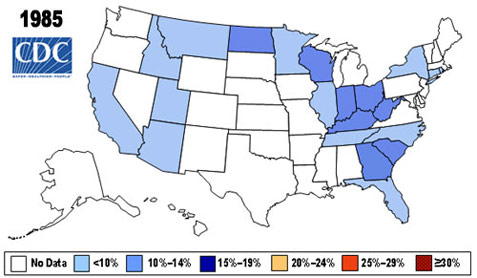
As illustrated in the above graphic, in 1985, 12 states had a prevalence of obesity less than 10 percent; eight states had a prevalence between 10 percent and 14 percent; and no states reported a prevalence of 15 percent or higher.
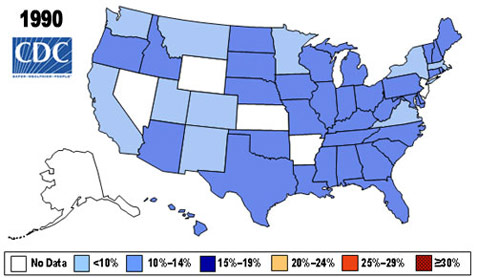
In 1990, 10 states had a prevalence of obesity less than 10 percent; 34 states had a prevalence between 10 percent and 14 percent; and no states reported a prevalence of 15 percent or higher.
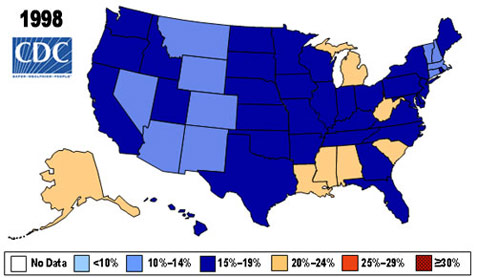
In 1998, not one state had a prevalence of obesity less than 10 percent; seven states had a prevalence between 20 percent and 40 percent; and no state had a prevalence equal to or greater than 25 percent
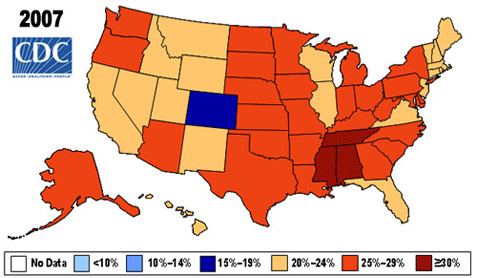
In 2007, only one state (Colorado) had a prevalence of less than 20 percent. Thirty states had a prevalence equal to or greater than 25 percent; three of these states (Alabama, Mississippi, Tennessee) had a prevalence of obesity equal to or greater than 30 percent.
According to two National Health and Nutrition Examination Surveys (NHANES), the prevalence of obesity for adults between the ages of 20 and 74 increased from 15 percent in the 1976 – 1980 survey, to 32.9 percent in the 2003 – 2004 survey (1). These same surveys also showed the number of adults considered to be overweight increased from 47 percent to an astounding 66.2 percent, with the sharpest swell in overweight and obesity occurring in the '90s. Thankfully, there seems to have been a leveling off of obesity rates since 1999, with no significant change between 2003 and 2006 for either men or women (2). However, despite this leveling of obesity rates, two-thirds of the people in the U.S. remain over weight or obese, and this is unacceptable.
Overweight and obese individuals are at an increased risk for many physical ailments, many of which result in disability and death (3).
- High blood pressure, hypertension
- High blood cholesterol, dyslipidemia
- Type II (non-insulin dependent) diabetes
- Insulin resistance/glucose intolerance
- Hyperinsulinemia
- Coronary heart disease
- Angina
- Congestive heart failure
- Stroke
- Cholecystitis (inflammation of the gall bladder) and cholelithiasis (gallstones)
- Gout
- Osteoarthritis
- Obstructive sleep apnea
- Asthma
- Some types of cancer (endometrial, breast, prostate and colon)
- Complications of pregnancy including: gestational diabetes, gestational hypertension, preeclampsia and complications in operative deliveries (i.e., c-sections)
- Poor female reproductive health (menstrual irregularities, infertility and irregular ovulation)
- Bladder control problems
- Psychological disorders like depression, eating disorders and low self esteem

Compared to individuals with normal weight, those who are overweight and obese are significantly more likely to be associated with diabetes, high blood pressure, high cholesterol levels, asthma, arthritis and fair to poor health (4).
The primary physical effects of being overweight, besides being cumbersome, are cardiovascular disease (CVD) and Type II diabetes. Hypertension, which is an independent risk factor for CVD, increases progressively as one becomes heavier. "Obese persons are six times as likely to have hypertension as compared to lean adults. These increases in hypertension translate into a 12 percent increased risk of coronary heart disease (CHD) and a 24 percent increased risk for stroke" (5). The relationship between diabetes, CVD and being overweight and inactive are nearly inescapable.
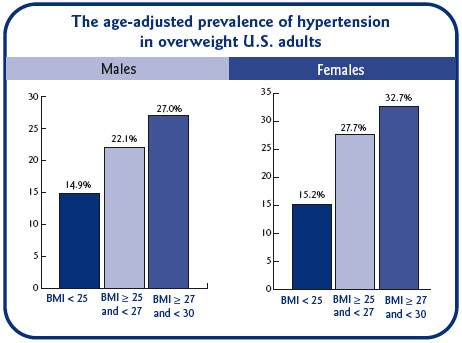
Diabetes comes with the territory. Data from the Centers for Disease Control (CDC) shows that more than 80 percent of people diagnosed with Type II diabetes are overweight or obese. The heavier you are, the higher the risk. And according to the American Heart Association, 75 percent of the people who have diabetes die from some type of CVD. Other problems associated with Type II diabetes include nerve damage, kidney damage, blindness, lowered immunity, osteoporosis and Alzheimer’s.
In the early 1900s, people with clogged arteries at any age were very rare. Most physicians during this time never witnessed a heart attack during their practice. Physicians who were trying to study cardiovascular disease had to search the country for patients.
By the mid '50s, CVD became our number one killer, and it remains the leading killer today. It was around this time that the lipid hypothesis started to gain popularity. The lipid hypothesis, which was proposed by Ancel Keys in the late '50s, is a theory claiming there is a direct relationship between the amount of saturated fat and cholesterol in the diet and the incidence of CVD.
Today in the United States one person will die from CVD every 37 seconds (6). This year an estimated 1.26 million people will have a new or recurrent heart attack, and just short of half will die (7). About 80 million people, or more than 25 percent of the U.S.’ population, has one or more forms of cardiovascular disease (7). In 2002, CVD mortality was nearly 60 percent of "total mortality" in the U.S. (6). That means that out of 2.4 million deaths from all causes, CVD was listed as a primary cause on about 1.4 million death certificates. CVD causes more deaths than the next seven causes combined. It’s safe to say that CVD had a meteoric rise from the 1930s to the 1950s to become number one, and to this day the incidence is still rising to a great extent because of our expanding waistlines.
 As a result of the inherent health risks, and the increasing number of obese individuals, obesity is the number two preventable cause of death in the United States (8). In 2000, obesity accounted for 365,000 deaths, which is 16 percent of all deaths. Tobacco, which is still the number one preventable cause of death, accounted for 435,000 deaths, or 18 percent of all deaths. And according to the study, the gap is narrowing. In 1990 obesity caused about 300,000 deaths, or 14 percent of the total, with tobacco causing 400,000 deaths, or 19 percent. If this trend continues at the same rate, obesity will soon reach the number one spot.
As a result of the inherent health risks, and the increasing number of obese individuals, obesity is the number two preventable cause of death in the United States (8). In 2000, obesity accounted for 365,000 deaths, which is 16 percent of all deaths. Tobacco, which is still the number one preventable cause of death, accounted for 435,000 deaths, or 18 percent of all deaths. And according to the study, the gap is narrowing. In 1990 obesity caused about 300,000 deaths, or 14 percent of the total, with tobacco causing 400,000 deaths, or 19 percent. If this trend continues at the same rate, obesity will soon reach the number one spot.
Unfortunately, the inherent health problems aren’t the only aspect of obesity we need to be concerned about. Being overweight and obese have a major economic impact on our health care system, with both direct and indirect costs. Direct costs may include prevention, diagnosis and treatment services (like physician visits, hospital and nursing home care). Indirect costs relate to morbidity and mortality. Morbidity costs are the value of wages lost from decreased productivity, disability and absenteeism. Mortality costs are the total value of future income lost by premature death.
The Surgeon General’s "Call to Action to Prevent and Decrease Overweight and Obesity," updated January 2007 states, "in 1995 the total (direct and indirect) costs attributable to obesity amounted to an estimated $99 billion. In 2000, the total cost was estimated to be $117 billion ($61 billion direct and $56 billion indirect). Most of the costs associated with obesity are due to Type II diabetes, CHD, and hypertension."
Fortunately, for our physical as well as economical health, the incidence of obesity among adults has statistically leveled off in recent years. We can only hope we’ve reached the peak of this trend and are on the downward side. Unfortunately, as the trend appears to have come to a halt with adults, it may continue to increase through our youth, according to the Centers for Disease Control and Prevention (CDC). Here is the situation:
- In 2005, only 33 percent of adults consumed fruit two or more times per day, and only 27 percent consumed vegetables three or more times per day.
- Despite the proven benefits of physical activity, fewer than half of American adults in 2007 engaged in enough physical activity to provide health benefits. (Shouldn’t adults lead by example? Many parents are neglecting their children’s health by leading unhealthy lifestyles.)
 Estimates suggest that since 1994, the overweight trend in youths has not leveled off as in adults, and is increasing to even higher levels. The 2003-2004 CDC findings for children and adolescents suggest another generation of overweight adults.
Estimates suggest that since 1994, the overweight trend in youths has not leveled off as in adults, and is increasing to even higher levels. The 2003-2004 CDC findings for children and adolescents suggest another generation of overweight adults. - It has been shown that the 80 percent of children who are overweight at aged 10 to 15 years were obese adults at age 25 years.
- More than a quarter of the children born in 2004 were never breastfed. Breastfeeding is associated with a reduced risk for obesity.
- The percentage of young people who are obese has tripled since 1980.
- More than one third of adolescents in grades 9 to 12 had a soft drink (not diet) at least one time per day during the previous seven days. (Soft drinks are almost exclusively sweetened with fructose or HFCS.)
- In 2007, 65 percent of young people in grades 9 to 12 did not get the recommended amount of physical activity; 35 percent watched TV for three or more hours on the average school day.
- 70 percent of obese children between the ages of five and 17 have at least one CVD risk factor, while 39 percent had two or more.
- Type II diabetes, which used to be referred to as adult onset diabetes, is now begun to emerge as a health-related problem among children and adolescents.
How did we as a country get so unhealthy? What caused our weight gain and its inherent health risks? Many self-proclaimed experts say, "Americans are eating too much." "It’s just a matter of calories-in versus calories-out." Is it really as simple as reducing the amount of food we eat, exercising more or both? Are we really eating too much, or is it what we’re eating? Do manmade substances in our food really make a difference in our ability to maintain a healthy weight? Most importantly, what can we do for ourselves and our children to ensure a healthy life?
Find out answers to these and other questions in Part 2 and Part 3 of this series!
SOURCES
1. CDC National Center for Health Statistics. "Prevalence of Overweight and Obesity Among Adults: United States, 2003-2004."
2. CDC National Center for Health Statistics Office of Communication. "Obesity Among Adults in the United States, No Statistical Significant Change Since 2003-2004," Data Brief Number 1, November 2007.
3. "Health Consequences of Obesity," khou.com.
4. Mokdad AH, et al. "Prevalence of Obesity, Diabetes, and Obesity-Related Health Risk Factors," 2001, "Journal of the American Medical Association," 2003;289:76-79.
5. Poirier, P, MD, et al. "Obesity and Cardiovascular Disease: Pathophysiology, Evaluation, and Effect of Weight Loss," "Circulation" 2006;113:898-918.
6. "Heart Disease and Stroke statistics – 2008 Update," americanheart.org, American Heart Association.
7. "Cardiovascular Disease Statistics," americanheart.org, American Heart Association.
8. Mokdad AH, et al. "Actual Causes of Death in the United States," "Journal of the American Medical Association," 2004;291:1238-1245.
You can follow us on Twitter and Facebook for content updates. Also, sign up for our email list for weekly updates and check us out on Google+ as well.













